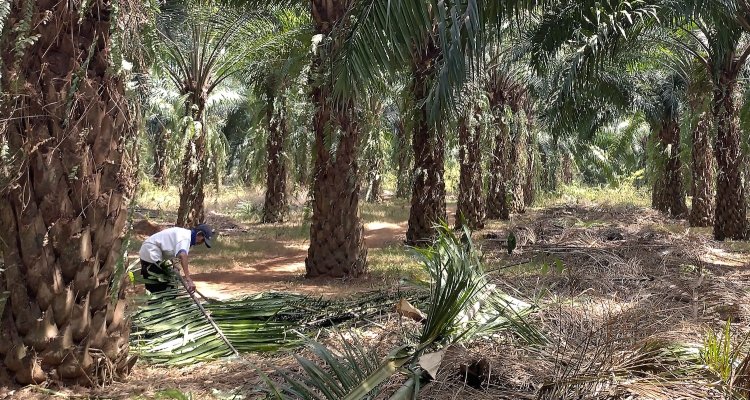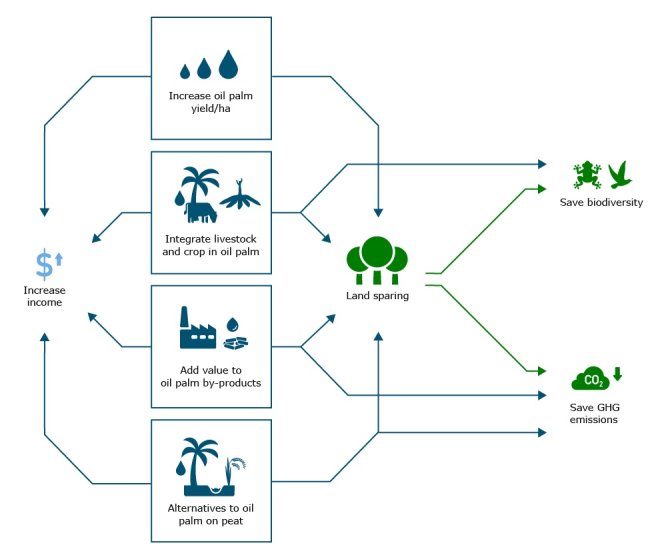
News
Making palm oil friendlier for environment and people
The establishment of new palm oil plantations can result in deforestation, and sometimes also the draining of swamps. This causes a decrease in biodiversity and creates significant CO2 emissions. Fortunately this can be improved. Wolter Elbersen, senior researcher at Wageningen University & Research (WUR) and project leader for the circular use of residues in the SustainPalm programme (Sustainable Palm Oil in Indonesia), explains how.
“Although production is declining in several countries and the use of palm oil is under pressure in Western countries, the demand for it is still growing. Logical, because it is a very versatile substance and farmers in production countries can earn a reasonable income with it. However, the often associated deforestation and draining of peatlands makes a significant part of palm oil unsustainable,” says Elbersen. That is why he and his colleagues, including Maja Slingerland (WUR) and Peter van der Meer (Van Hall Larenstein), and researchers from the IPB and ULM universities in Indonesia, are looking for solutions that make deforestation unnecessary and offer alternatives to the cultivation of oil palm on peat while also providing farmers with a good income. “Using land more efficiently through intercropping, increasing yields and better use of crop residues leads to land savings. It not only saves land but also labor and other inputs. Truly a win-win for everyone.”
Land saving on the plantation means land conservation elsewhere
In the SustainPalm programme, Elbersen and colleagues are working on implementing innovations in four themes: increasing the yield of the oil palm, integrating livestock farming and other crops in the plantations, valorizing by-products and finding alternatives for the cultivation of oil palm on peat. Wageningen University & Research has decades of research experience into the use of residues. Elbersen: “By also using the by-products for valuable products, you can make do with less land. Valuable substances no longer have to be extracted directly from crops growing in fields - which takes up land and other inputs. Think of sugar cane or cassava plantations or timber plantations. This way the knife cuts both ways.”
Saving hundreds of thousands of hectares
Plantations in Malaysia and Indonesia increasingly need to be replanted now that they are 25 years or older and palm oil production is declining. That is why it is important to replant more effectively and efficiently now, instead of expanding into undeveloped land. For example, the ten-meter-high trunk and the rest of the biomass are now left behind in the field. Elbersen: “We know from previous research that these contain an estimated 5 tons of starch and glucose per hectare, especially in the upper part of this trunk. After the trunk has been pushed over, sugar water can be harvested from the top for weeks, which is boiled down into so-called gula (sugar). In the parallel PalmStarch project we are working on optimizing this, among other things, by being able to predict which trunks can supply a lot of gula and which cannot. This way, small entrepreneurs can work more profitably and a larger part of the potential is unlocked. This could save hundreds of thousands of hectares of sugar cane production.”

Veneer and less energy consumption
The lower two-thirds of the trunk can be used for veneer or other wood products. Elbersen: “We are now analyzing this application on a much larger scale while not adding negative effect to the soil. In addition, many by-products and residues are also released at the local processing plant close to the plantation where the fresh fruit bunches containing oil-containing fruits are processed."
Part of the by-product is now burned to produce steam for the factory, but the researchers also see possibilities there: “At the moment, these residues have little to no applications. The effluent is processed in open tanks, releasing methane. But from previous research we know that you can also run the factory on steam made from biogas made from the waste water ('effluent') and the empty palm bunch," says Elbersen. This leads to less CO2 emissions and less energy consumption in the factory.
Investigating barriers to innovations together with the local population
These various (technical) innovations have already been proven effective in previous studies. However, they are not yet implemented. This SustainPalm programme, commissioned by the Dutch Embassy in Indonesia and in collaboration with the Indonesian Ministry of Economic Affairs, is carried out in living labs on site and explicitly investigates the barriers and promotes implementation. Edwin Hamoen, programme manager Nature Based Materials at WUR: “The starting point of this program is that this is tackled together with local partners; both companies and governments, but certainly also farmers and communities. They also want to contribute to a sustainable palm oil industry.” Elbersen adds: “The questions we try to answer are: What is the reason why some changes do not come about? What technical, economic and policy barriers are there? And how can we break through that? We investigate the effectiveness and feasibility of these innovations in practice. In this way, together with industry and government, we can contribute to making the palm oil industry more sustainable on a large scale.”